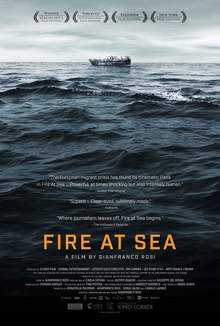
This is billed as a documentary but it’s debatable whether it’s more of a film than a documentary. Its original Italian title makes more sense, Fuocoammare, in reference to a song that a woman requests on the radio in honor of the men who work as fishermen in the family. Apparently the Italian Prime Minister liked it so much that he gifted a DVD of it to each of the EU’s heads of state.
Set on and around the island of Lampedusa off the coast of Sicily, this film switches back and forth between two narratives. One covers the lives of the local inhabitants, focusing in particular on a twelve-year old boy. The other covers the migrants crossing the Mediterranean is dangerous and horribly crowded boats and the efforts of the authorities to rescue them. The scenes of the boy show him playing with his slingshot, in school or learning to row and so on. There are also shots of the island’s local DJ, the boy’s grandparents and a diver harvesting produce from the surrounding waters. The scenes of the migrants start with the authorities detecting and attempting to communicate with the boats. They then send helicopters to search for them and use boats of their own to rescue the migrants, giving priority to the sickest ones who are still alive. We watch them as they processed and treated, with some especially powerful scenes of them living in the camps once they reach land.
The odd thing is that there is almost no interaction between these two narratives. The closest point of contact is a doctor who bemoans the horrible conditions on the boats and later treats the Italian boy for a medical complaint which turns out to be a minor problem. The migrants never interact with any of the Italian residents and the Italians never even talks about them. My wife commented that perhaps the point is to draw a contrast between the two communities on the same island. Certainly while the locals on Lampedusa aren’t rich and clearly work hard for their living, they enjoy a degree of security and comfort that the mostly African migrants can only dream about. An even better contrast might be seen in their attitudes. Young as he is, the boy is assertive and free-spirited, wandering the island at will and confidently asking questions of the doctor. The Africans on the other hand are beaten down and battered, bitter about their losses and uncertain about what the future holds for them. It’s not a bad comparison but the connection seems a bit too tenuous to hand a whole film on.
Even judged separately, the scenes are excellent. It’s hard not to admire the verve of the boy as he goes about pretending to shoot guns, struggles with a lazy eye problem and generally muck about. There’s a charming, old-fashioned feel to life on the island, yet at the same time you can see that they enjoy modern conveniences and first world medical services. As for the migrants, the film reminds us that poor and desperate as they are, these are people who have ideas, thoughts and feelings of their own. One astonishing scene shows them performing a sort of ballad of their suffering as they flee from one country to the next, unwelcome everywhere, leaving more and more of their number dead at each stop. Oddly enough, this film also serves as a wonderful record of the logistics and procedures of the Italian authorities. It’s morbidly fascinating to watch them go about their work as they issue foil blankets to them for example, or prioritize moving the sickest first while leaving most of the corpses alone.
All in all, this is an informative hybrid between a documentary and a film. The closest thing to narration that it has is when the doctor talks about what it’s like to work with the migrants. We never know the names of any of the persons but I presume they are all real people and not actors. It’s not as emotionally moving as I thought it would be because of how it sort of holds the audience at arm’s length but this also prevents it from coming across as being preachy. Overall, it’s an interesting film that is well worth watching.
One thought on “Fire at Sea (2016)”